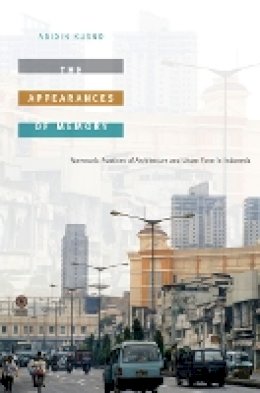Abidin Kusno is Associate Professor at the Institute of Asian Research and Faculty Associate of the Department of Art History, Visual Art, and Theory at the University of British Columbia, where he holds a Canada Research Chair in Asian Urbanism and Culture. He is the author of Behind the Postcolonial: Architecture, Urban Space, and Political Cultures in Indonesia.
“[U]nique and engaging. . . . [M]akes a considerable contribution to the discourse on ‘memory’ in architecture and urban studies, and in particular to broadening the understanding – and reading – of urban space within postcolonial nations.” - Shenuka de Sylva, Asia Pacific Viewpoint “[Kusno] provides a brilliant diachronic cartography of different architectural and urban elements in contemporary Jakarta and their connection to or disjuncture from the past. . . . [T]his is an exceptional and truly enjoyable book, a good companion to the author’s previous book, Behind the Postcolonial (2000).” - Eduardo AscensÃo, Planning Perspectives “[T]he essays are well-designed, their themes are carefully developed, and there is ample evidence to give credence to the conclusions that are drawn. The essays are scholarly, unambiguous, and meaningful to the reader. The use of examples from architecture are well-chosen and make the collection an especially good representative of this genre. The author’s two major themes. . .are a strong contribution to the scholarly literature on the history and architecture of Java. . . . [T]he work is well done and worth reading.” - Howard M. Federspiel, Indonesia “This fine book has its origins in a series of essays published in the aftermath of the May 1998 rioting in Jakarta and the birth of the post-Suharto era, the product of the so-called reformasi. . . . Photos and line drawings feature among some 60 illustrations, and there is a comprehensive bibliography, which includes, as might be expected, Indonesian and Dutch works. . . . I would highly recommend this book overall. . .” - John P. Lea, Architectural Science Review “The Appearance of Memory is very much a revisionist work that deftly manages a plethora of knowledge and detail about the Indonesian city to provide new insight into its dynamics. The book is full of pithy summations that deftly capture well developed themes in Indonesian sociological studies, but, more importantly, it contextualizes these themes through insightful analysis of architectural forms.” - Robbie Peters, Oceania "This…book demonstrates deep theoretical reflection on a number of different issues around the theme of memory as they are inscribed in material and spatial phenomena…. [Kusno] exposes social challenges that Asian nations deliberately suppress and architectural/urban studies rarely acknowledge." - Anoma Pieris, Comparative Studies in Society and History “The Appearances of Memory offers fresh perspectives and intriguing analyses of the political culture of Indonesia as expressed through architecture, development, spatial relationships, and other facets of urban development in the colonial and national periods. It is further evidence of Abidin Kusno’s unique capacity to probe the inner life of Indonesia’s distinct political culture and to connect it to the structures that give it meaning.”-Christopher Silver, author of Planning the Megacity: Jakarta in the Twentieth Century “I have always felt that we in Indonesia studies have been unusually lucky in having people thinking at the brink of the discipline, pushing the boundaries of the field. Abidin Kusno is one of those people. The Appearances of Memory is an extraordinary book.”-Rudolf MrÁzek, author of A Certain Age: Colonial Jakarta through the Memories of Its Intellectuals “The Appearance of Memory is very much a revisionist work that deftly manages a plethora of knowledge and detail about the Indonesian city to provide new insight into its dynamics. The book is full of pithy summations that deftly capture well developed themes in Indonesian sociological studies, but, more importantly, it contextualizes these themes through insightful analysis of architectural forms.” - Robbie Peters (Oceania) “[Kusno] provides a brilliant diachronic cartography of different architectural and urban elements in contemporary Jakarta and their connection to or disjuncture from the past. . . . [T]his is an exceptional and truly enjoyable book, a good companion to the author’s previous book, Behind the Postcolonial (2000).” - Eduardo Ascensão (Planning Perspectives) “[T]he essays are well-designed, their themes are carefully developed, and there is ample evidence to give credence to the conclusions that are drawn. The essays are scholarly, unambiguous, and meaningful to the reader. The use of examples from architecture are well-chosen and make the collection an especially good representative of this genre. The author’s two major themes. . .are a strong contribution to the scholarly literature on the history and architecture of Java. . . . [T]he work is well done and worth reading.” - Howard M. Federspiel (Indonesia) “[U]nique and engaging. . . . [M]akes a considerable contribution to the discourse on ‘memory’ in architecture and urban studies, and in particular to broadening the understanding – and reading – of urban space within postcolonial nations.” - Shenuka de Sylva (Asia Pacific Viewpoint) “This fine book has its origins in a series of essays published in the aftermath of the May 1998 rioting in Jakarta and the birth of the post-Suharto era, the product of the so-called reformasi. . . . Photos and line drawings feature among some 60 illustrations, and there is a comprehensive bibliography, which includes, as might be expected, Indonesian and Dutch works. . . . I would highly recommend this book overall. . .” - John P. Lea (Architectural Science Review) "This…book demonstrates deep theoretical reflection on a number of different issues around the theme of memory as they are inscribed in material and spatial phenomena…. [Kusno] exposes social challenges that Asian nations deliberately suppress and architectural/urban studies rarely acknowledge." - Anoma Pieris (Comparative Studies in Society and History)

